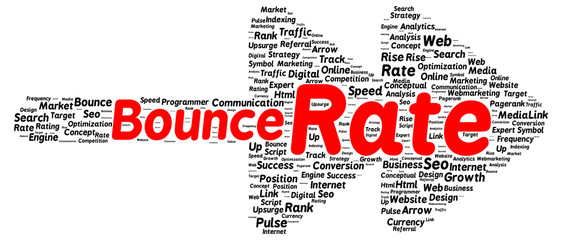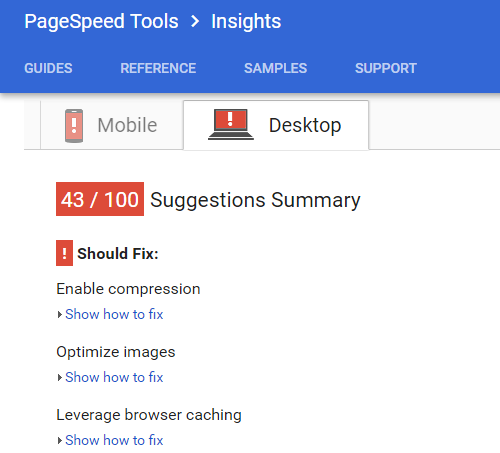
Does your website have high bounce rate? If yes, you need to work on these common reasons making the visitors leave your site.
Having a high bounce rate means the majority of visitors leaving your site after viewing only one page. In this scenario, converting those visitors into your customers or subscribers is quite difficult task. You are not alone as nearly every site faces bounce rate anywhere from 26% (excellent) to 70% (pathetic).

But it can’t be denied that traffic is extremely important for your website, no matter if you are e-commerce store or a blogger. So, you must identify those reasons costing your visitors leaving your website so that you can reduce your website’s bounce rate.
For your help, here we have listed the major reasons of high bounce rate along with the quick solution.
1) Loading Time is Too Slow
A user is likely to leave slow loading webpage, no matter how useful content it has to offer. In simple words, a slow loading time will make the users flee your webpage soon. Sadly, most of the businesses don’t take the load time of their website seriously, thereby attracting high bounce rate. If you are one of those businesses, here are some eye-opening (shocking) statistics for you.
- 47% web users want a web page to load in two seconds or less
- 79% of web shoppers who have a trouble with web site performance say they won’t return to the site to buy again
- 40% will leave the site if page takes more than 3 seconds to load
- 44% of them would suggests friends and other to not use that site citing their poor experience
- Google has started ranking websites according to their page load time
In this way, you lose thousands of potential customers just because of the few seconds’ delays.
Review your page speed with the tools like Google PageSpeed Insights, Pingdom, and GTMetrix. They suggests you recommendations, like compressing your images, minimizing third-party scripts, and other improvements. So, it advisable to work on your website loading speed so that you can boost your website conversion rate easily.

2) Poor Content Readability
Having great content on your website is not enough, factors like how text has been organized over your web page? Is it readable? Is it simple enough to be understood by a visitor etc., matters a lot.
Nobody likes to go through chunks of paragraph. People read things online to get the information they seek, and they want it the quickest and the simplest way possible.
A website that has good content readability will make the visitor stay on the page longer, thereby reducing the bounce rate.
Here are the ways you can improve the content readability of your site:
- Keep your words short and simple
- Use short sentences
- Use big and bold headlines
- Use bullet points to explain benefits
- Divide the paragraphs into 4-5 lines
- Font should be easy to read—neither too big nor too small
3) Annoying Popups
Pop up helps you increase conversations, getting more visitors subscribed to your products and newsletter. However, they can be annoying if occur frequently or at the wrong time, disrupting the user’s focus on your content.
Therefore, you must test the timings of the pop-up. Make sure that they don’t occur at the time when a visitor lands on your page.
4) Poor Design
Look at your website. Do you find it really appealing? If you don’t, you can’t expect an average user to stick it for a longer. For example:
Your product may not be in the focus or the text is running here and there without white spaces with unorganized content layout. The search bar is missing when a user wants to explore more or there is no easy navigation.
Needless to say these things will make the user depart from your page in no moment. Remember, design is essential to enhance the user’s experience, so always follow the latest website design trends.
5) It is Not Mobile Responsive:
You can’t afford to have unresponsive site when 56% of traffic to the websites is from mobile devices. It simply means that mobile friendly website is the best way to engage your visitors and lower your bounce rate. Even Google is paying more attention on mobile optimized website as it came up with new search engine algorithm- Mobilegeddon in 2015. And then in 2016, Google came up with Accelerated Mobile Pages, which aim at making mobile pages with heavy content load faster.
Check what your site looks like and how it is easy to while using it over smartphone. If it is not effortlessly accessible on mobile then a time has come to make it responsive for the smartphone and other IoT devices. If your site is on WordPress, several plugins can help it to be mobile friendly.
You can also read: 10 Amazing Tips to Optimize Your Landing Page for Mobile
6) Misleading Title Tag and Meta Description:
Make sure your webpage is well described through its title tag and Meta description. If not, it may mislead the visitor who seeks the things that are not available on your webpage. Therefore, he leaves your site and never come back.
In 2016, Google had extended the character limit for Meta titles and description which allow us to describe our website more effectively.
So, don’t forget to pay attention to the meta tags of your website. Whether you create them by mistake or they are the part of your strategy, you must fix the shady Meta tags and title description of your page before it’s too late.
7) No Call to Action
If your page lacks call to action, visitor would have no idea what to do next or where to go. It won’t make your site compelling either. For instance, if your visitor is looking to subscribe your newsletter, or if they want to buy something but can’t find the appropriate instructions amidst brags, there would be an issue.
Having a clear call to action means a user knows quickly what his next step should be and how to find it on the page. Make your calls to actions simple and compelling.
8) Complicated Site Navigation
Site navigation matters a lot for the overall user experience. A web user has no reason to stay on the “messy” site where finding information is quite complicated. This is why you must keep your site’s navigation simple as if it is designed for the first time user.
According to a 3 click rule, a user must be able to find the information they’re looking for within three mouse clicks or less, or else they depart quickly to check out other search results.
Bottom Line:
These are the major mistakes you must avoid to improve your bounce rate. However, it is equally true that you can’t get overnight results by fixing them. It takes your time and skills as well to let you reap the benefits in the long run.
You can also read: Top SEO Trends That Will Dominate This Year- 2017

Started working as a digital marketing expert, Varun Sharma is now also a well-known digital marketing speaker – a speaker on performance development, and a trusted mentor to businesses in the digital world. His keynote expositions are based on the digital marketing theories, which provide a fascinating insight into the secrets of high performance.

